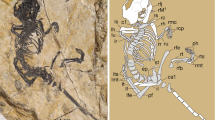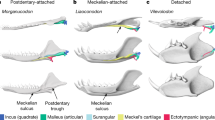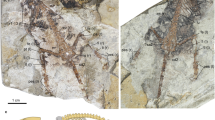Abstract
ACANTHOSTEGA gunnari, from the Upper Devonian (Famennian) of East Greenland, is the most primitive known tetrapod, and retains many fish-like characters1–4. I report here the discovery of further well preserved specimens that show the earliest known tetrapod braincase, and shed light on the history of the tetrapod ear region. The fenestra ovalis is shown to be derived directly from the vestibular fontanelle5,6, a hole in the sidewall of the braincase of fishes seen in their embryology and in primitive fossil fish adults. The hole is not a uniquely tetrapod character7,8. A specialized auditory fenestra ovalis may have evolved more than once among tetrapods. As in other tetrapods, the stapedial footplate of Acan-thostega fitted into the fenestra ovalis, but instead of being free to vibrate as part of an ear, was firmly held there, forming a major component of the braincase wall. It was the only component linking the otic capsule to the palate. Though the stapes may have carried muscles operating a spiracular valve, the new material suggests that it was not a mobile component of the skull as previously suggested4. The stapes, spatially replacing parts of the fish brain-case including the process carrying facets for the hyomandibular articulation9, has a footplate which incorporates both heads of the sarcopterygian hyomandibula.
This is a preview of subscription content, access via your institution
Access options
Subscribe to this journal
Receive 51 print issues and online access
$199.00 per year
only $3.90 per issue
Buy this article
- Purchase on Springer Link
- Instant access to full article PDF
Prices may be subject to local taxes which are calculated during checkout
Similar content being viewed by others
References
Coates, M. I. & Clack, J. A. Nature 352, 234–236 (1991).
Clack, J. A. & Coates, M. I. in Deciphering the Natural World and the Role of Collections and Museums (eds Hoch, E. & Brantsen, A. K.) 39–42 (Geological Museum Copenhagen, 1993).
Coates, M. I. & Clack, J. A. Nature 347, 66–69 (1990).
Clack, J. Nature 342, 425–130 (1989).
Jarvik, E. Basic Structure and Evolution of Vertebrates Vol. 1 (Academic, London, 1980).
Gardiner, B. G. Bull. Br. Mus. (nat. Hist.) Geol. 37, 173–428 (1984).
Gaffney, E. S. Bull. Carn. Mus. nat. Hist. 13, 92–105 (1979).
Panchen, A. L. & Smithson, T. R. Biol. Rev. 62, 341–438 (1987).
Smithson, T. R. & Thomson, K. S. Zool. J. Linn. Soc. 74, 93–103 (1982).
de Beer, G. R. The Development of the Vertebrate Skull (Clarendon, Oxford, 1937).
Lombard, R. E. & Bolt J. R. Biol. J. Linn. Soc. 11, 19–76 (1979).
Clack, J. A. in The Evolutionary Biology of Hearing (eds Webster, D. B., Fay, R. R. & Popper, A. N.) 405–420 (Springer, New York, 1992).
Beaumont, E. I. Phil. Trans. R. Soc. B280, 29–101 (1977).
Smithson, T. R. Zool. J. Linn. Soc. 76, 29–90 (1982).
Clack, J. A. & Holmes, R. B. Palaeontology 31, 85–107 (1988).
Romer, A. S. & Witter, R. V. J. Geol. 50, 925–960 (1942).
Panchen, A. L. & Smithson, T. R. in The Phytogeny and Classification of Tetrapods, Vol. 1: Amphibians, Reptiles and Birds (ed. Benton, M. J.) 1–32 (Clarendon, Oxford, 1988).
Jarvik, E. Kungl. svenksa vetensk. acad. handl. 5, 1–104 (1954).
Moy-Thomas, J. A. & Miles, R. S. Palaeozoic Fishes (Chapman and Hall, London, 1971).
Vorobyeva, E. I. & Schultze, H.-P. in Origins of the Higher Tetrapod Groups (eds Trueb, L. & Schultze, H.-P.) 68–109 (Cornell Univ. Press, New York, 1991).
Eaton, T. J. J. Wash. Acad. Sci. 29, 109–117 (1939).
Huxley, T. H. Proc. zool. Soc. Lond. 1876, 24–59 (1876)
Goodrich, E. S. Studies on the Structure and Development of Vertebrates 1958 edn (Dover, New York, 1930).
Wake, M. H. Hyman's Comparative Vertebrate Anatomy 3rd edn (Univ. Chicago Press, Chicago, 1979).
Carroll, R. L. in The Terrestrial Environment and the Origin of Land Vertebrates (ed. A. L. Panchen) 293–318 (Academic, London, 1980).
Allis, E. P. J. Anat. 56, 189–294 (1922).
Author information
Authors and Affiliations
Rights and permissions
About this article
Cite this article
Clack, J. Earliest known tetrapod braincase and the evolution of the stapes and fenestra ovalis. Nature 369, 392–394 (1994). https://doi.org/10.1038/369392a0
Received:
Accepted:
Issue Date:
DOI: https://doi.org/10.1038/369392a0
This article is cited by
-
Comparative iTRAQ proteomics revealed proteins associated with lobed fin regeneration in Bichirs
Proteome Science (2019)
-
Morphology of the earliest reconstructable tetrapod Parmastega aelidae
Nature (2019)
-
The origin of terrestrial hearing
Nature (2015)
-
The Fish–Tetrapod Transition: New Fossils and Interpretations
Evolution: Education and Outreach (2009)
-
The cranial endoskeleton of Tiktaalik roseae
Nature (2008)
Comments
By submitting a comment you agree to abide by our Terms and Community Guidelines. If you find something abusive or that does not comply with our terms or guidelines please flag it as inappropriate.



